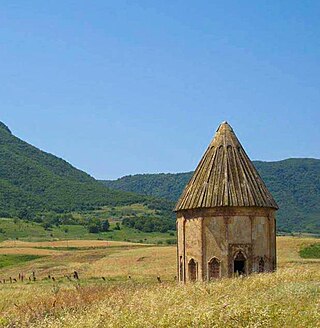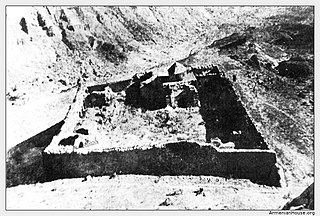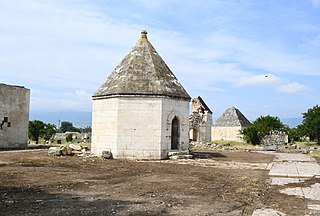Related Research Articles

Susanlyg or Mokhrenes is a village in the Khojavend District of Azerbaijan, in the disputed region of Nagorno-Karabakh. The village had an ethnic Armenian-majority population prior to the 2020 Nagorno-Karabakh war, and also had an Armenian majority in 1989.
Aza is a village and municipality in the Ordubad District of Nakhchivan, Azerbaijan. It is located on the left side of the Ordubad-Nakhchivan highway, 17 km southeast of the district centre, on the right bank of the Gilanchay River. Its population is busy with gardening, vegetable-growing, farming and animal husbandry. There are secondary school, club and a medical center in the village. It has a population of 442.
Çənnəb is a village and municipality in the Ordubad District of Nakhchivan, Azerbaijan. It is located at the foot of the mountain, 32 km in the north-west from the district center. Its population is busy with gardening, beekeeping, farming and animal husbandry. There are secondary school, library, club and a medical center in the village. It has a population of 507.

Şurud, also Shorot or Shurut is a village and municipality in the Julfa District of Nakhchivan, Azerbaijan. It is located 23 km to the north of the district center, on the slope of the Zangezur mountain range.
Parağa is a village and municipality in the Ordubad District of Nakhchivan, Azerbaijan. It is located in the near of the Ordubad-Tivi highway, 48 kilometres in the north-west from the district centre, on the left bank of the Gilanchay river, on the slope of the Zangezur ridge. Its population is engaged in gardening, vegetable-growing, and animal husbandry. There are secondary school, club, library and a medical centre in the village. It has a population of 306 in 2005.
Bist is a village and municipality in the Ordubad District of Nakhchivan, Azerbaijan. It is located in the near of the Ordubad-Nurgut highway, in the north-west from the district center. Its population is busy with gardening, beekeeping and animal husbandry. There are secondary school, club, library and a medical center in the village. It has a population of 483.
Çalxanqala is a village and municipality in the Kangarli District of Nakhchivan, Azerbaijan. It is located 33 km in the north-west from the district center, on the south slope of the Daralayaz ridge. Its population is busy with grain-growing, vine-growing, beekeeping and animal husbandry. There are secondary school, music school, library, club and a medical center in the village. It has a population of 2,149. It was the last Armenian-populated town in Nakhchivan.

Khachin-Darbatli Mausoleum or Khachen-Dorbatli Mausoleum is a tomb-mausoleum of Qutlu Khwâdjah located close to the Khachindorbatli village of the Aghdam District of Azerbaijan. It was built by the medieval Armenian architect Vardapet Shahik in 1314. The mausoleum is located 23 km to the north of Aghdam and is on the list of heritage sites of the Republic of Azerbaijan as a 14th-century memorial monument of Karabakh.

Holy Saviour Monastery of Julfa was an Armenian Apostolic monastery, located north-west of Jugha cemetery at the end of the gorge, 3 km away from the cemetery, on that slope of a high mountain. In the southern part of the monastery, at the foot of the Magharda mountain range, the Araks River flows.

The Imarat Garvand cemetery, or simply as the Imarat cemetery is a royal cemetery and a complex located in Aghdam, Azerbaijan. It contains the graves of some of the Azerbaijani and Turkic nobility of the Karabakh Khanate.
St. Astvatsatsin Church was an Armenian church located in Anaqut village of the Nakhchivan Autonomous Republic of Azerbaijan. The church was located in the northeastern district of the village.
St. Hovhannes Church was an Armenian church located on a hill in the center of the former village of Berdak, near the current Dyrnys village of the Nakhchivan Autonomous Republic of Azerbaijan.

St. Astvatsatsin Monastery was an Armenian monastery located in Çənnəb village of the Nakhchivan Autonomous Republic of Azerbaijan. It was located in the northern district of the village.
St. Targmanchats Monastery was an Armenian monastery located in Nürgüt village of the Nakhchivan Autonomous Republic of Azerbaijan. It was located in the central part of the village.

Mesrop Mashtots Monastery or St. Gr. Lusavorich Monastery was an Armenian monastery located in Nəsirvaz village of the Nakhchivan Autonomous Republic of Azerbaijan. The monastery was located in the western part of the village.
St. Nshan or Kopatap Monastery was an Armenian monastery located near Bist village of the Nakhchivan Autonomous Republic of Azerbaijan. The monastery was located 1 km north of the village.
Church of Shrju was an Armenian church located near Tivi village of the Nakhchivan Autonomous Republic of Azerbaijan. The church was located some 2 km north-east to Tivi village, in the southeastern part of the abandoned village of Shrju.
Amenaprkich Monastery was an Armenian monastery in Gazanchy village of the Nakhchivan Autonomous Republic of Azerbaijan. The monastery was located in the center of the village.
St. Astvatsatsin Monastery or Kusakan Monastery was an Armenian monastery located in the village of Shurud of the Nakhchivan Autonomous Republic of Azerbaijan. The monastery was located approximately 1 km north of the village.
St. Stepanos Monastery was an Armenian monastery located near the village of Shurud of the Nakhchivan Autonomous Republic of Azerbaijan.
References
- ↑ "Adam Smith - Anthropology Cornell Arts & Sciences". anthropology.cornell.edu. Retrieved 9 April 2018.
- ↑ "Adam T Smith - Cornell University - Academia.edu". cornell.academia.edu. Retrieved 9 April 2018.
- ↑ "Adam Smith | Anthropology Cornell Arts & Sciences".
- ↑ "John Simon Guggenheim Foundation - Adam T. Smith". www.gf.org. Retrieved 9 April 2018.